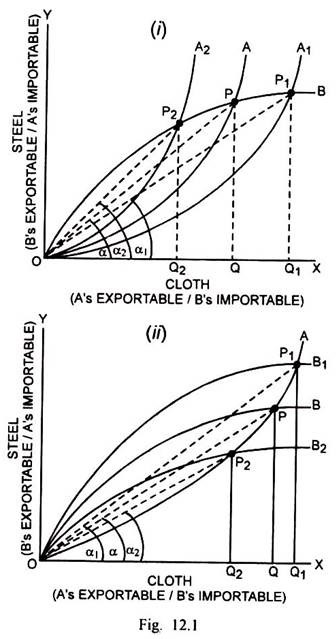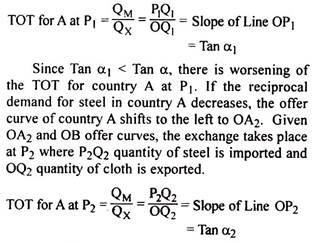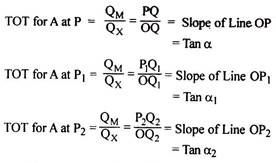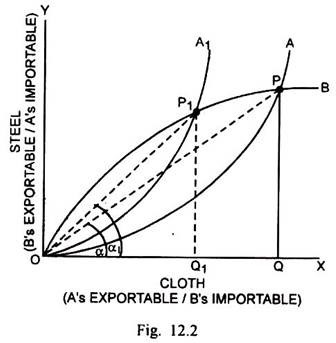The terms of trade among the trading countries are affected by several factors.
Some prominent factors out of them are discussed below:
Factor # 1. Reciprocal Demand:
The reciprocal demand signifies the intensity of demand for the product of one country by the other. If the demand for cloth, exportable commodity of country A, is more intense (or inelastic) in country B, the latter will offer more units of steel, its exportable product, to import a given quantity of cloth. On the contrary, if the demand for cloth in country B is less intense (elastic), then B will offer smaller quantity of steel to import the given quantity of cloth.
If the reciprocal demand for steel in country A increases, the offer curve of country A will shift to the right as it will be willing to offer more quantity of cloth for the given import of steel. On the contrary, a decrease in the reciprocal demand for steel in country A, will cause a shift in its offer curve to the left as it will offer a lesser quantity of cloth to import the same quantity of steel. In the former case, the terms of trade get worsened and in the latter case they get improved for country A.
ADVERTISEMENTS:
From the point of view of country B, if there is an increase in the reciprocal demand for cloth in country B, the offer curve of this country will shift to the left and the terms of trade for this country become favourable. On the opposite, a decrease in the reciprocal demand for cloth in country B results in a shift in the offer curve of this country to the right. The consequence is the worsening of the terms of trade for this country.
In Figs. 12.1 (i) and 12.1 (ii), cloth, the exportable commodity of country A and importable commodity of country B, is measured along the horizontal scale. Steel, the exportable commodity of country B and importable commodity of country A, is measured along the vertical scale.
In Fig. 12.1 (i), given the offer curves OA and OB of countries A and B respectively, exchange takes place at P where country A imports PQ quantity of steel and exports OQ quantity of cloth.
If the reciprocal demand for steel in country A increases, the offer curve of A shifts to the right to OA1. The intersection of OA1 and OB takes place at P1, which is the point of exchange. At this point, country A imports P1Q1 quantity of steel and exports OQ1 quantity of cloth.
Since Tan α2 > Tan α, there is an improvement in the terms of trade for country A in this situation.
In Fig. 12.1 (ii) originally OA and OB are the offer curves of countries A and B respectively. The exchange takes place at P where country A imports PQ quantity of steel and exports OQ quantity of cloth. If reciprocal demand for cloth in country B increases, the offer curve of country B shifts to the left to OB1.
ADVERTISEMENTS:
The exchange, in this case, takes place at P1 and country A imports P1Q1 quantity of steel and exports OQ1 quantity of cloth. If the reciprocal demand for cloth in country B decreases, the offer curve of country B shifts to the right to OB2. In this case exchange takes place at P2 where country A imports P2Q2 quantity of steel and exports OQ2 quantity of cloth.
Since Tan a1 > Tan α, there is an improvement in the terms of trade for country A at P1 and worsening of the terms of trade for country B. Since Tan α2 < Tan α, there is worsening of the terms of trade for country A at P2 and improvement in the terms of trade for country B.
Factor # 2. Tariff:
When a country imposes tariffs on imports from the foreign country, it implies a lesser willingness to absorb the foreign products. It means the reciprocal demand in the tariff- imposing country for the foreign product has got reduced. The tariffs or import duties are, therefore, likely to improve the terms of trade for the tariff- imposing country. It may be explained through Fig. 12.2.
In Fig. 12.2, OA is the offer curve of country A and OB is the offer curve of country B. Their intersection determines the point of exchange P where country A imports PQ quantity of steel and exports OQ quantity of cloth. The TOT for country A at P = (QM/QX) = (PQ/OQ) = Slope of Line OP = Tan α.
When tariff is imposed by country A on steel, the offer curve of country A shifts to the left to OA1. The exchange now takes place at P1 where P1Q1 quantity of steel is imported in exchange of OQ1 quantity of cloth. The TOT for A at P1 = (QM/QX) = (P1Q1/OQ1) = Slope of Line OP1 = Tan α 1. Since Tan α1 > Tan α, the terms of trade have become favorable for the tariff-imposing country A.
In this connection, it should be remembered that tariff will improve the terms of trade for the tariff-imposing country, if the elasticity of offer curve of the other country is more than unity but less than infinity. If the foreign country B imposes retaliatory tariff of the equivalent or relatively larger magnitude, the effect of imposition of tariff by the first country A may get off-set or more than off-set.
Factor # 3. Changes in Tastes:
The terms of trade of a country may also be affected by the changes in tastes. If tastes or preferences of the people in country A shift from the product Y of country B to its own product X, the terms of trade will become favourable to country A. In an opposite situation, the terms of trade will turn against this country. It may be shown through Fig. 12.3.
In Fig. 12.3, the offer curves OA and OB of countries A and B respectively intersect each other at P. At this point of exchange, country A imports PQ quantity of Y and exports OQ quantity of X.
The TOT for country A at P = (QM/QX) = (PQ/OQ) = Slope of Line OP = Tan α. If people in country A do not have a stronger preference for the commodity Y and their preference or taste shifts towards their own product X, the offer curve of country A shifts to the left to OA1. Now exchange takes place at P1. Country A buys P1Q1 quantity of Y in exchange of OQ1 quantity of X. The TOT for country A at P1 = (QM/QX) = (P1Q1/OQ1) = slope of Line OP1 = Tan α1. Since Tan α1 > Tan α, there is an improvement in the terms of trade for country A. On the opposite, the shift in preference towards the foreign product Y will result in the worsening of terms of trade for the home country A.
Factor # 4. Changes in Factor Endowments:
If there is an increase in the supply of labour in country A, specialising in the production of labour-intensive commodity cloth, while factor endowments in country B remain unchanged, the fall in labour cost will lower the price of cloth. Consequently, more quantity of cloth will be offered by country A for the same quantity of steel resulting in the terms of trade becoming unfavourable to A. If labour becomes scarcer in this country, the terms of trade are likely to become favourable for it. This may be shown through Fig. 12.4.
ADVERTISEMENTS:
In Fig. 12.4, given OA and OB as the offer curves of countries A and B respectively, exchange takes place originally at P. Country A exports OQ quantity of cloth and imports PQ quantity of steel.
The TOT for country A at P = (QM/QX) = (PQ/OQ) = Slope of Line OP = Tan α. If there is an increase in the supply of labour in this country, the price of labour will fall. There will also be a fall in the price of labour-intensive commodity cloth relative to the price of steel. For the same quantity of cloth, now less quantity of steel can be bought.
Therefore, the offers curve of country A shifts to the right to OA1. The exchange takes place at P1 where P1Q1 quantity of steel is imported in exchange of OQ1 quantity of cloth. The TOT for country A at P1 = 9QM/QX) = (P1Q1/OQ1) = Slope of Line OP1 = Tan α1. Since Tan α1 < Tan α, terms of trade become unfavourable for country A subsequent to change in the factor endowments, i.e., increased supply of labour.
Factor # 5. Changes in Technology:
The terms of trade of a country get affected also by the changes in techniques of production. As there is technological improvement in the home country, say A, there is rise in productivity and/or a fall in the cost of producing exportable commodity, say cloth. If the technological progress is labour-saving in this labour-intensive export sector (cloth industry) there will be worsening of the terms of trade as the offer curve of country A will shift to the right. This may be explained through Fig. 12.5.
ADVERTISEMENTS:
In Fig. 12.5, OA and OB are the-offer curves of countries A and B respectively. The exchange takes place at P where PQ quantity of steel is imported in exchange of OQ quantity of cloth.
The TOT for A at P = (QM/QX) = (PQ/OQ) = Slope of Line OP = Tan α. If labour-saving technical progress takes place in the labour-intensive export sector (cloth industry), the offer curve of country A shifts to the right to OA1 where P1O1 quantity of steel is imported in exchange of OQ1 quantity of cloth. The TOT for country A at P1 = (QM/QX) = (P1Q1/OQ1) = Slope of Line OP1 = Tan α1. Since Tan α1 < Tan α, there is worsening of the terms of trade for this country after technological progress.
In case this type of technical progress takes place in the import-competing sector in this county, there will be an improvement in the terms of trade. If capital-saving technical progress takes place in labour-intensive export sector, there can still be the possibility of improvement in the terms of trade.
Factor # 6. Economic Growth:
The economic growth involves a rise in real national product or income of a country over a long period. As growth takes place, there is an expansion in the productive capacity of the country. The increased productive capacity may result from the increased supply of productive factors. It is supposed that there are two countries A and B.
The former is the labour-abundant home country and cloth is its exportable product, which is labour-intensive. Steel, the capital-intensive commodity, is its importable product from the foreign country B. The offer curves of two countries are given.
ADVERTISEMENTS:
As the supply of labour in the labour- abundant country A increases or growth takes place, the offer curve of this country will shift to the right. The cost and price of exportable commodity falls relative to the cost and price of steel in country B. As a result, this country will offer more quantity of cloth for the same quantity of steel. In this situation, the terms of trade will get worsened for the growing home country A, although the volume of trade will get enlarged.
If the supply of scarce factor capital increases, subsequent to growth, the cost and price of importable good steel will fall relative to the price of cloth. More quantity of steel can be obtained for the same quantity of cloth. In this case, the offer curve of country A will shift to the left. This will cause the improvement in the terms of trade for the growing home country A but the volume of trade will get reduced. This may be explained through Fig. 12.6.
In Fig. 12.6, originally OA and OB are the offer curves of two counties. The exchange takes place at P. Country A exports OQ quantity of cloth and imports PQ quantity of steel. The TOT at P = (QM/QX) = (PQ/OQ) = Slope of Line OP = Tan α. If growth takes place and supply of abundant factor labour increases, the offer curve of A shifts to the right to OA1 and exchange takes place at P1. P1Q1 quantity of steel is imported and OQ1 quantity of cloth is exported. The TOT for A at P1 = (QM/QX) = (P1Q1/OQ1) = Slope of Line OP1 = Tan α1.
Since Tan α1 < Tan α, there is worsening of the terms of trade for the home country after growth. Since there is an expansion of both exports and imports, the volume of trade has however, increased. If growth involves the increased supply of scarce factor capital, the offer curve of country A will shift to the left to OA2. In this case, exchange takes place at P2. The quantity imported of steel is P2Q2 whereas the quantity exported of cloth is OQ2.
The TOT at P2 = (QM/QX) = (P2Q2/OQ2) = Slope of Line OP2 = Tan α2.
ADVERTISEMENTS:
Since Tan α2 > Tan α, the terms of trade for the growing home country have improved. But in this case, the volume of trade of the country has decreased. The export and import of cloth and steel respectively have been less than quantities transacted before the process of growth.
In the above two cases, it was assumed that the relative prices of the two commodities undergo change. Suppose the prices of cloth and steel remain unchanged even after growth, the terms of trade will remain unchanged. If growth involves increased supply of abundant factor labour and prices of two commodities remain the same, the exchange may occur at P4 where the slope of line OP is exactly equal to the slope of line OP4 (P and P4 lie on the same line).
The terms of trade remain the same there, although the volume of trade is much larger than at P. If there is increased supply of scarce factor capital but the prices of commodities remain the same, the exchange occurs at P3. The terms of trade at P3 are exactly equal to the term of trade at P (both the points lie on the same line OP). So there is no change in the terms but the volume of trade is smaller than volume of trade at the original position P. It is now clear that growth process can lead to deterioration or worsening of the terms of trade or these may remain unchanged.
Factor # 7. Devaluation:
Devaluation is the reduction of the value of home currency in relation to the value of foreign currency. Since devaluation causes a lowering of export prices relative to import prices, the terms of trade are supposed to get worsened after devaluation of the home currency.
In fact there is much controversy about the impact of devaluation upon the terms of trade among the economists. F.D. Graham and several other classical theorists held the view that the devaluation would leave the terms of trade unaffected because the countries transact at the international prices upon which they have little control.
The neo-classical, theorists, including Joan Robinson, on the contrary, maintained that most countries specialised in the export of a few commodities, the foreign demand of which was relatively inelastic while, at the same time, they imported such goods, the supply of which was relatively more elastic. Consequently devaluation tends to deteriorate their terms of trade.
ADVERTISEMENTS:
This is particularly true in the case of the developing countries. If, however, the country enjoys a monopsony power, it will specialise in imports while exporting a variety of goods. It is likely to make imports at a lower price even after devaluation and the terms of trade, as a consequence, will get improved.
The devaluation can be successful or effective if the export prices fall and import prices rise. It means the successful devaluation is likely to make the commodity terms of trade unfavourable. Even the gross barter terms of trade are likely to turn adverse in the event of successful devaluation that result in a balance of trade surplus. As a matter of fact, whether the terms of trade will become adverse or favourable, is determined by the elasticities of demand and supply of exports and imports of the devaluing country.
If the elasticities of supply of exports and imports are higher than the elasticities of demand for exports and imports, so that the product of demand elasticity co-efficients is less than the product of supply elasticity co-efficients (DX.DM < SX.SM), there will be deterioration in the terms of trade after devaluation. Here DX and DM are elasticity coefficients of the demand for exports and imports respectively. SX and SM are the elasticity coefficients of supply of exports and imports respectively.
If the product of elasticity co-efficients related to demand for exports and imports is exactly equal to the product of the elasticity co-efficients of supply of exports and imports respectively (DX.DM = SX.SM), the devaluation will leave the terms of trade unchanged. If the product of elasticity co-efficients of demand for exports and imports is greater than the product of elasticity co-efficients of supply of exports and imports, (DX.DM > SX.SM), there will be an improvement in the terms of trade after devaluation.
To sum up, the terms of trade will worsen, remain unchanged and improve, consequent upon devaluation, if:
Factor # 8. Balance of Payments Position:
If a country is faced with a deficit in balance of trade and payments and it has to adopt measures intended to restrict import and enlarge exports such as internal deflation, devaluation, import and exchange controls, the terms of trade are likely to get worsened. On the opposite, a trade and payments surplus may be tackled through the exchange appreciation and reflationary policies. As a consequence, the terms of trade may get improved.
Factor # 9. International Capital Flows:
ADVERTISEMENTS:
An increased flow of capital from abroad involves larger demand for the products of the creditor country and consequent rise in the prices of imported goods. The rise in prices of imports relatively to the prices of exports causes deterioration in the net barter terms of trade. When the borrowing country makes repayments of outstanding loans, there is outflow of capital.
In order to get hold of required foreign currencies for making repayments, there may be sale of home-produced goods at rather low prices. The fall in export prices relative to import prices will again result in the deterioration in the net barter terms of trade.
Factor # 10. Import Substitutes:
If there is sufficient production of close substitutes for import goods within the home country, its reciprocal demand for the foreign products will be weak and the terms of trade are likely to become favourable for the home country. On the opposite, if the close substitutes of the import goods are not available in the home country, the reciprocal demand for foreign products may be relatively high. As a result, the terms of trade are likely to be unfavourable for the home country.
There can be several other minor influences upon the terms of trade such as price movements, business cycles, transfer problems and political conditions.









